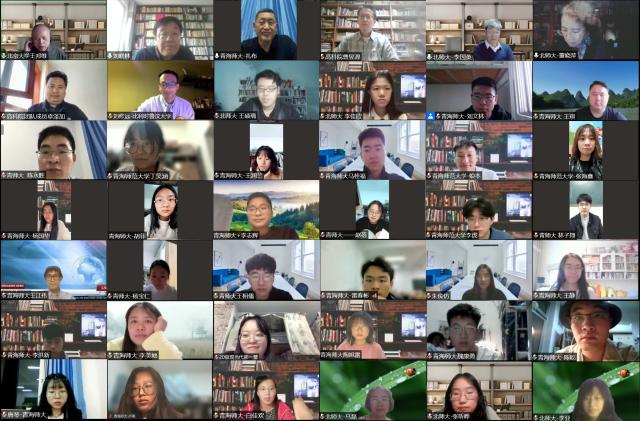青海师范大学中国语言文学一级学科研究生通识课程
“跨文化中国学研究方法论”第六讲
王邦维教授《圣山与大河:一个有关青藏高原的神话传说》

主讲教授简介:王邦维,北京大学博雅讲席教授,我国著名佛教史、东方学、中印交流史研究专家。季羡林先生培养的我国第一位印度语言文学专业博士。英国剑桥大学、美国哈佛大学、德国哥廷根大学留学、高访和工作。印度比哈尔邦那烂陀大学董事会成员。北京大学东方学研究院院长、北京大学印度研究中心主任。教育部人文社科重点研究基地北京大学东方文学研究中心首任主任。曾任国务院学位委员会第五届和第六届学科评议组外国语言文学组成员。王邦维教授著述自上世纪80年代起已产生了较大的国际影响,获国际级和国内奖项的主要有:与季羡林先生等合注《大唐西域记校注》获陆文星、韩素音中印友谊奖(1987)和国家图书奖一等奖(1993)。个人学术专著《大唐西域求法高僧传校注》获陆文星、韩素音中印友谊奖(1985),《南海寄归内法传校注》获北京市第四届哲学社会科学优秀成果一等奖(1996)和教育部全国高等学校第二届人文社科研究优秀成果三等奖(1998),《跨文化的想象:文献、神话与历史》获中版好书奖(2019)和社科优秀图书奖(2020)。在国内以及德国、法国、印度、日本、瑞典、爱沙尼亚、尼泊尔、美国、荷兰、丹麦出版有各类学术著作和发表学术论文多篇。其新著《玄奘与<大唐西域记>》和《佛教史话六讲》是支持“教育援青”人文学科基础建设的力作。
2022年4月16日,青海师范大学中国语言文学一级学科“跨文化中国学研究方法论”研究生课进入第六讲,继续由北京大学王邦维教授主讲,题目为《圣山与大河:一个有关青藏高原的神话传说》。青海师范大学文学院,青海师范大学民族师范学院、青海师范大学高原科学与可持续发展研究院、北京师范大学跨文化研究院师生、欧洲高校研究生近80人在线听讲。青海师范大学文学院副院长刘晓林教授主持本课。
王邦维教授本讲仍以《大唐西域记》为蓝本,但不再是讲单篇个案,而是研究一个总体性问题,即在《大唐西域记》的《序论》中记载了不少山川地点,其中一些是与青藏高原有关的圣地地名,在它们背后,是神话传说史、地名学与佛教概念史建构的关系。这是人文科学史上的一个经典问题,近年也成为跨文化研究的共享课题。在今天强调尊重文化多样性的国际思潮中,研究这种文本,关注其多元叙事类型的神话传说文本、多元地标性质的地名学和多元信仰因素的宗教概念,还具有重要的学术价值和社会现实意义。
王邦维教授在本讲中重点谈到的《大唐西域记》圣地地名有:“赡部洲”、喜马拉雅山、喀喇昆仑山、帕米尔高原、“无热恼池”、“四河”和“五河”。这些讨论都是在前期大量研究的基础上进行的,包括研读印度佛经《俱舍论》《大毗婆沙》《发智论》和南传巴利经典《长阿含》《那先比丘经》,我国古代经史子集典籍《史记》《括地志》《水经注》和郦道元在书中引用外来文献《释氏论》、和《扶南传》等。通读和分析这些卷帙浩繁的文献,是旷日持久的工作。王教授本课讲授的要点是:解读《大唐西域记》之《序论》,玄奘的说法来自何处,历史文献溯源,对高山与大河的地理学考察,中印神话传说的对接,以及进一步思考的问题。
我们可以把王邦维教授的观点概括为以下几点:1)从叙事文本看,《大唐西域记》圣地地名解释只是一些神话性的传说,也有少许地理痕迹,但附会了很多想象成分。2)从地名学上看,千百年来,四条大河或五条大河,一直是中亚和南亚最重要的河流,不过对任何国家民族的地名知识又与原生地的社会历史和文化传统有关,即便是传诵圣地地名,彼此也未必一致,甚至互相都想不到。像四河中的阿姆河,玄奘认为是黄河,他也有他的文献依据;印度人则认为是印度的河,当时印度人不会有中国人的想法。但在玄奘的生前身后,中国绵长的历史文献对这些地名续有记载,从印度返回的玄奘将他在印度看到的和想到的著书立说,就提供了一个中印交集点。3)文化交集点与宗教信仰结合,就能在地方社会扎根,并向深处发展,因为信仰故事的兼容性比信仰本身更宽泛。
直至19世纪至20世纪中叶还是印欧文化论主宰的时代,中国学者的声音是微弱的。这种中西差距有多大?仅从中国神话传说在以印欧故事为主的AT中不足2%的分布数据就能说明,而且AT以神祇、人类和动物故事为主,山川地名故事稀见,《大唐西域记》以东方叙事方式见长,还增加了圣地地名叙事,这就有自己的独特性。王邦维教授的研究说明,《大唐西域记》可以作为一个范本,启示我们,在文化主体性中产生这类混用体裁文献能够呈现跨文化性。中国学者和国际学界对《大唐西域记》的研究已经形成跨文化的研究史,但学者还要始终注意本民族自身的分类,如唐玄奘和中国古代学者对四河的分类,印度人民对四河的分类,青藏高原多民族人民古往今来对四河的分类等。对这类文献继续扩大研究,可以建设人类共享文化财富。

王邦维教授《圣山与大河:一个有关青藏高原的神话传说》的授课现场(2022年4月16日)
接下来,著名青海藏学家、青海师大原原副校长扎布教授就青藏高原地区长期传承的圣地文献和高山大河传说进行了系统介绍,就其多元文化分布和本民族分类方式做了补充解释,双方还就藏语文献的保护利用开展了对话,精彩的学术交流将这次讲课推向高潮。青海师范大学文学院副院长刘晓林教授对今天的课程做了全面总结。
Postgraduate General Course of the First-Level Discipline
Chinese Language and Literature of Qinghai Normal University
“Methodology of Transcultural Study on Chinese Society and Culture” Invites
Professor Wang Bangwei to Deliver Lecture on:
Sacred Mountains and Great Rivers: A Myth about Qinghai-Tibet Plateau
On April 16th, 2022, the sixth lecture of “Methodology of Transcultural Study on Chinese Society and Culture”, postgraduate general course of the first-level discipline Chinese Language and Literature of Qinghai Normal University, was delivered online by Professor Wang Bangwei from Peking University. The title of his lecture was “Sacred Mountains and Great Rivers: A Myth about Qinghai-Tibet Plateau”. Nearly 80 participants attended the lecture online, including postgraduates and teachers from College of Chinese Language and Literature of Qinghai Normal University, Teachers College for Nationalities of Qinghai Normal University, Academy of Plateau Science and Sustainability of Qinghai Normal University, College of Transcultural Studies of Beijing Normal University, and European Universities. Professor Liu Xiaolin, vice dean of College of Chinese Language and Literature of Qinghai Normal University, presided over the lecture.
Professor Wang Bangwei’s lecture is still based on The Great Tang Dynasty Record of the Western Regions, but it is no longer about individual cases, but about an overall problem. In the preface of The Great Tang Dynasty Record of the Western Regions, there are many mountains and rivers, some of which are the names of sacred places related to the Qinghai-Tibet Plateau. Behind them, there exist relationships constructed by the history of myths and legends, toponymy and the history of Buddhist concepts. This is a classic question in the history of humanities and has become a shared topic in transcultural studies in recent years. In current international trend of respecting cultural diversity, it is of great academic value and social practical significance to study this kind of text and concentrate on its myth and legend texts of multiple narrative types, toponymy with multiple landmark natures and religious concepts of multiple belief factors.
In this lecture, professor Wang Bangwei focused on the names of sacred places in The Great Tang Dynasty Record of the Western Regions. For instance, Jambudvipa, Himalayas, Karakoram, Pamir Plateau, Anavatapta, “Four Rivers” and “Five Rivers”. Those discussions were conducted based on the extensive research, including the study of Indian Buddhist scriptures such as Abhidharmakosha, Abhidharma-mahavibhasa-sastra, Jnanaprasthana-sastra, the Pali canon Dirghagama-sutra and Milindapanha, ancient Chinese classics such as Shih Chi, Kuo Di Zhi and Commentary on the Waterways Classic, and ancient books and records cited by Li Daoyuan such as Shi Shi Lun, Fu Nan Zhuan, etc. It took a long time to read and analyze the voluminous literature. The main points of Professor Wang’s lecture are: the interpretation of the preface in The Great Tang Dynasty Record of the Western Regions, historical document tracing, geographical investigation of mountains and rivers, Chinese and Indian myths and legends, as well as issues for further discussion.
Professor Wang Bangwei’s views can be summarized as follows: 1) From the perspective of narrative text, the explanation of those sacred place names in The Great Tang Dynasty Record of the Western Regions is based on some mythological legends, with little geographical traces but many imaginary elements. 2) From the perspective of toponymy, for thousands of years, four or five major rivers have been the most important rivers in Central and South Asia. However, the knowledge of place names of any nationality is related to the social history and cultural tradition of the original place. Even if the names of sacred places are passed down, those names may not necessarily consistent or relevant. Take amu darya for example. With documentary evidence, Xuanzhang thought it was the Yellow River. While Indians thought it was an Indian river. Indians and Chinese could not reach consensus at that time. However, Chinese historical documents record those places uninterruptedly before and after Xuanzang’s period. Xuanzang’s return from India to write about what he saw and thought in India provides an intersection point between China and India. 3) When cultural intersection points are combined with religious belief, they can take root in local society and develop in depth, because the compatibility of belief stories is broader than belief itself.
From the 19th century to the middle of the 20th century, the Indo-European cultural theory dominated the era and the voice of Chinese scholars was weak. How big is the gap between China and the West? This can be explained from the fact that Chinese myths and legends only account for less than 2% in AT distribution data, which is dominated by Indo-European stories. Besides, AT is dominated by stories of gods, humans and animals, while stories of place names of mountains and rivers are rare. The Great Tang Dynasty Record of the Western Regions is good at oriental narration, and it also adds the narration of place names of sacred places, which has its own uniqueness. Professor Wang Bangwei’s research shows that The Great Tang Dynasty Record of the Western Regions can serve as a model to inspire us to produce such mixed genre documents in cultural subjectivity to present transcultural characteristics. Scholars at home and abroad have formed a history of transcultural research on The Great Tang Dynasty Record of the Western Regions. However, they should always pay attention to the classification of their own ethnic groups, such as the classification of Four Rivers by Xuanzang and ancient Chinese scholars, the classification of Four Rivers by the Indian people, and the classification of Four Rivers by the multi-ethnic people on the Qinghai-Tibet Plateau of all ages.
Afterwards, Professor Zha Bu, the renowned Tibetologist in Qinghai and former vice principal of Qinghai Normal University, made a systematic introduction to the long-inherited sacred place texts and legends of mountains and rivers on the Qinghai-Tibet Plateau, and gave a supplementary explanation on their multicultural distribution and ethnic classification. The two sides also had a dialogue on the protection and utilization of Tibetan texts, pushing the lecture to a new high. Professor Liu Xiaolin, vice dean of College of Chinese Language and Literature of Qinghai Normal University, made a comprehensive summing-up of today’s lecture.
